Titles by Jack Weatherford
|
Titles by Jack Weatherford |
|
|
||
|
(Photo from the dust jacket of the first edition of Indian Givers) |
We're nowhere near neutral about Jack Weatherford. He's a friend, a member of the Archive Project Advisory Board from the beginning, and a truly human being.
He has also written some of the most important available books about America's hidden history. If you ever find yourself asking the questions, "How did things get this way?" "What really happened?" or "Where did that idea come from?" then there are at least two of his books that belong on your special bookshelf — Indian Givers and Native Roots.
But an absolutely integral part of the experience of reading his books, is the insight into Jack's unique point of view and experience. There is a very rich flow between him, as an author, and the reader of his books. And part of the joy of reading his work is the experience of sharing the evolution of his viewpoint and interests over the years since the publication of his first book, Tribes on the Hill, in 1981. We really recommend that if you share our enthusiasm for any of his books, take the time to go back and read them sequentially. You will find treasures you would otherwise have missed.
One of the things we have noticed about authors and artists is that it is often very difficult to locate a single place, in either the real world or "L-space," where everything available in their catalogue can actually be found. We plan to address this for selected authors and recording artists, so that if you share our enthusiasms, you can basically "get it all" —in one place. Jack is the first of these selections, and we are very proud of our choice.
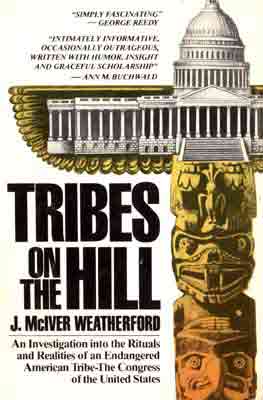 Tribes on the Hill: The U.S. Congress--Rituals and
Realities
Tribes on the Hill: The U.S. Congress--Rituals and
Realities
by J. McIver Weatherford
(Cover image is from the 1981 first edition)
The first hardcover edition of Tribes on the Hill was published in 1981 by Rawson, Wade Publishers. It was Jack's first published book, and was based on his studies leading to a Doctorate in Anthropology from the University of California at San Diego, his experience as a Fellow at the Institute of Policy Sciences at Duke University, and his service as a legislative assistant to Senator John Glenn.
The dust jacket for the first edition said:
"The United States Congress is vastly more intriguing, amusing—and disturbing—than it has ever shown itself to be. What do Senators and Representatives have in common with the pig-and-yam farmers of New Guinea, Watutsi warriors, Byzantine eunuchs, or courtiers at Versailles? More than anyone ever dreamed. Freshman representatives, for example, undergo an initiation ceremony echoing that of a fierce and remote Amazon tribe. The Congress revealed here is a collection of rival clans struggling like any human tribe for influence and continuity.
"The greatest problem facing a young anthropologist today is that the world is running short of "undiscovered" tribes. Jack Weatherford, a trained and experienced anthropologist, located his tribe on the top of Capitol Hill. As a congressional staffer, he participated in and recorded the rituals and realities of Congress. Beneath the press conference verbiage, the high ceremony of committee hearings and the occasional low comedy of congressmen at play, the piercing and ironic eye of the author sees what really goes on among our elected representatives—and why it keeps going on.
"Such universal concerns as getting and holding power, establishing totems and taboos, laying down pecking orders of deference and domination are, for an anthropologist, readily apparent in the actions of 'sophisticated' congressmen and 'primitive' people alike. Yet beyond these resemblances, it becomes clear that the future of Congress poses deeply troubling questions. The tribes, in their self-regarding rituals, are lost in a wilderness of power, and their very survival is threatened by the demands of the present and an expectant electorate."
"Like Timbuktu, Sodom, and Babylon, the City of Washington shimmers on the edge of reality, more a state of mind than a physical place. its blurred pastiche of scandal, power, and money in inconceivably enormous sums combines to paint a larger than life scene that provokes awe, comedy, and dread. As some site lost in time and space and enshrouded in the fogs of myth, Washington evokes sensations more like a convulsive shudder from the primal memory than rational understanding. . . .
"There is nothing outrageous and certainly nothing invidious in comparing the American Congress with an East African baraza, with the Senate of Rome, or with a tribal council in New Guinea. On the very spot where the House Appropriations Committee meets to divy up a $600 billion annual budget, it is quite possible that a group of Indians gathered to distribute the day's fish harvest or to divide a mastodon. The process differed in the scope of its results, but not necessarily in the way the results were decided. Under the same ancient tree where a congressman pauses to tape a short television interview for the evening news, it is possible that an Indian chief once addressed his own supporters in preparation for a battle, hunt, or trading expedition."
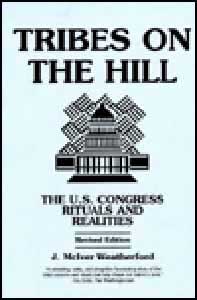
The original hardcover edition of Tribes on the Hill is out-of-print. The newer hardbound and softcover editions are available for $69.95 and 32.95, respectively, and are stocked in small quantities. We are currently talking to the used-book community in the Twin Cities about the possibility of providing finders services to Archive visitors who would like a first edition.
![]() (We
are currently refurbishing and expanding these shelves and changing over to a
completely integrated payment system for our customers, but we will be happy to
honor orders received by e-mail during this interim. Click
button to send us your orders or comments.)
(We
are currently refurbishing and expanding these shelves and changing over to a
completely integrated payment system for our customers, but we will be happy to
honor orders received by e-mail during this interim. Click
button to send us your orders or comments.)
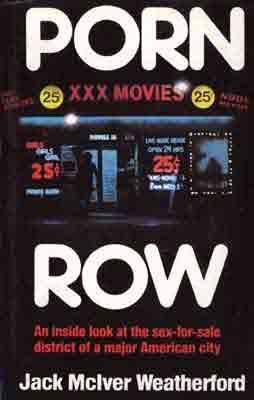 Porn Row : An Inside Look at the Sex-For-Sale District of a Major American City
Porn Row : An Inside Look at the Sex-For-Sale District of a Major American City
by Jack McIver Weatherford
(Cover image is from the first edition, 1986)
The first hardcover edition of Porn Row was published in 1986 by Arbor House and we have been unable to identify a paperback edition.
This was Jack's second published book, and is based on his effort to understand an American sub-culture by actually experiencing it.
The dust jacket for the first edition said:
"LIVE! GIRLS! ADULTS ONLY. XXXX FILMS. Peep shows. Massage parlors. Skimpy-skirted women slouched in the entryways to these purveyors of who knows what. Stringy-haired boys who loiter in front of the bars, hustling themselves to passerby. Sex for sale—every kind of sex for every appetite. Who sells? Who buys? What really goes on in the 'porn rows' of America?
"Jack McIver Weatherford is an anthropologist. Anthropologists study cultures in their native settings. He has often gone to remote sites in pursuit of his work, but he is equally intrigued by contemporary societies. Porn row takes us to an accessible site indeed: the porn district of Washington, D.C., where sex was for sale along Fourteenth Street and its environs, within sight of the White House.
"As an anthropologist, Weatherford felt he could learn about the society he wanted to study only by participating in it, so he found a job as a clerk in a store he calls the Pink Pussy. In the front room he sold magazines (organized by category: soft porn, hard porn, swingers, kinky) and myriad sexual paraphernalia, while in the back room, in the peep booths, the sex films rolled day and night, a quarter for two minutes, two bucks a film, and sex was bought and sold.
"With Weatherford we come to know the people who work in the area and the customers who frequent it. There is a rhythm to life on porn row, a rhythm determined by the work of those who buy its services: the morning rush of construction workers, the lunchtime office break, the afterwork tide of bureaucrats when government offices close. We get to know the lurking violence, the solitude and hunger and joylessness of the sex there. And with Weatherford, we come to recognize the discrepancy between our prudery about sex and our obsession with it. We learn about sexual attitudes not only here but in other societies—and see how and why sex in America has become a big, ugly business.
"Porn Row is both a fascinating personal story and a wide-ranging, probing look at why these sleaze centers exist in every major city and what they reveal about this most elemental of human instincts."
All previously published editions of this book are presently out of print, but we have located a few, near-new-condition copies of the hardcover first edition, and are offering the first of these for sale at $39.75 (US).![]() (We
are currently refurbishing and expanding these shelves and changing over to a
completely integrated payment system for our customers, but we will be happy to
honor orders received by e-mail during this interim. Click
button to send us your orders or comments.)
(We
are currently refurbishing and expanding these shelves and changing over to a
completely integrated payment system for our customers, but we will be happy to
honor orders received by e-mail during this interim. Click
button to send us your orders or comments.)
Indian
Givers : How the Indians of the
Americas Transformed the World
by Jack Weatherford
(Cover image is from the
first edition, 1988)
In 1988, Crown Publishers brought out Jack's third book.
Some of us regarded it as an instant classic. Previous popular assumptions about
what came to be known as the "Columbian Exchange" toppled like
dominoes. While it never became a best seller, it very quickly found its way
onto the reading lists of colleges and universities everywhere, as well enjoying
an extremely high exchange rate between friends.
Here at the Northern Plains Archive Project, and in our conversations all across the plains, it was transforming. Suddenly there were data, and well told stories, and someone much more well educated than us who was asking, and answering, some of the same questions with which we had been struggling.
It was a book completely full of answers to the basic questions of "What the heck really happened when...." and "Where did we get..." and "How come... ." To this day, it remains what it was then—validating and empowering and conversation-provoking and altogether wonderful. As was said earlier, this one should be on every thinking American's personal bookshelf.
The dust jacket for the first edition said:
"Not until humanity encounters another form of intelligent life somewhere
in space will there be anything comparable in its effect to the discovery of the
Indian "New World" by the European "Old World." Indian
Givers is a lively and engrossing fusion of past and present in which Jack
Weatherford dramatically shows to what degree 'the culture of [Indian]
America remains a mystery, still terra incognita after five hundred years.'
"Gold and silver in undreamed-of quantities led Europeans to exploit and then colonize the vast continents of the Americas—in the process pushing the misnamed 'Indian' inhabitants first into exploitation and ultimately into marginality and historical oblivion. But the new world's wealth financed the rise of modern Europe, led to its ultimate industrialization, and overwhelmed old craft and mercantile patterns through the development of factories and plantations, new processes and techniques, and 'companies' that served as the ancestors of modern corporations.
"The Indians gave us three-fifths of the foods consumed today. The potato alone revolutionized European agriculture and led to sweeping social changes. From one American plant came chocolate; from another, cocaine. Chilies, mistakenly called peppers, enlivened the cuisines of China, Hungary, and Italy, as well as Mexico.
"Even as the Europeans gave the Indians diseases and Christianity, they overlooked almost as much as they took from the world of the Indians. From icy Hudson's Bay to cloud-shrouded mountains and dense rain forests in South America, Jack Weatherford takes the reader to places where white men discovered Indian cures for diseases as well as Indian ideas for organizing democratic societies. And in a dazzling and engrossing survey he brings out all that Indians have given to the world, and what we are learning from them even now."
(From the back cover)
"The Indians gave us:
"Wealth: The gold and silver from the Americas was the source of major economic and trade expansion in Europe and eventually led to the industrial Revolution. The ore was mined largely with Indian labor—and just getting it out of the earth forced the Indians and Europeans to refine and create undreamed-of industrial techniques and systems.
"Food: Some 60 percent of the food eaten in the world today is of American origin. The potato changed Europe's agricultural economy and the nature of society, as well as feeding the large European armies from the eighteenth century on. Chocolate became the taste sensation of Europe; peppers, or chilies, enlivened cuisines throughout the world.
"Modern corporations and business: The 'companies' that established the first settlements and built plantations and 'factories' were the ancestors of the great commercial enterprises of today; they would not have survived or flourished had it not been for the labor and lives of the Indians.
"The federal system of government: The caucus in which politicians meet and voters select candidates is an Indian word and invention. The American Federal system derives not from Europe but from Indian tribal organizations—as Benjamin Franklin and George Washington, both highly knowledgeable about Indian Society and culture, could attest.
"Medicines: The Indians provided quinine, the first effective treatment for malaria. They offered a sophisticated pharmacy that contributed much to modern medicine in the form of aspirin-related tree bark extracts, laxatives, painkillers, antibacterial medicines, petroleum jelly, and much, much more.
(Cover image is from the softcover edition.)
"Indian Givers offers dramatic and amazing insights into Indian achievements in architecture and agriculture (a road system that rivaled that of the Romans, 'agricultural experiment stations' in the high Andes). They had an attitude toward the natural world that anticipated modern ecology, and religious concepts and spiritual insights that were and are profoundly enriching for the rest of humanity, laws often more humane than their European equivalents, a collective summa of wisdom and experience almost totally ignored by the culturally arrogant white newcomers. As Jack Weatherford concludes: 'Columbus arrived in the New World in 1492, but America has yet to be discovered."
The hardcover edition of Indian Givers is presently out-of-print. We offer the paperback edition for $13.00 US, plus shipping and handling.
![]() (We
are currently refurbishing and expanding these shelves and changing over to a
completely integrated payment system for our customers, but we will be happy to
honor orders received by e-mail during this interim. Click
button to send us your orders or comments.)
(We
are currently refurbishing and expanding these shelves and changing over to a
completely integrated payment system for our customers, but we will be happy to
honor orders received by e-mail during this interim. Click
button to send us your orders or comments.)
Native Roots : How the Indians Enriched America
by Jack Weatherford
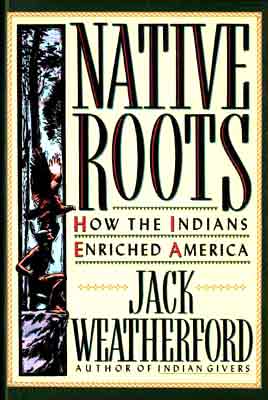
(Cover image is from the first edition, 1991)
In 1991, Crown published Native Roots, and the paperback was published by Ballantine in late 1992. This is the other Jack Weatherford volume that we find essential to personal bookshelves, and like Indian Givers, we find ourselves re-reading it in whole or part, from time to time.
In a way, this book narrows the target of native contributions from world-wide to this continent, and it follows on nicely from its predecessor. In another way, however, this is a prequel to Indian Givers, if you think like we do. It begins by couching the discussion we are about to enjoy with the author within the context of the ancient history of contact between urban and tribal nations, first studied by Abd-al-Rahman Ibn Khaldun in the 1300's, and continuing today.
This viewpoint is starkly in contrast to that which has underlain much of American culture, both academic and popular, in the last 400+ years. It forces us to confront the context which was fed to us in movies and history texts—that it was all about the contact between "civilization" and "savagery."
The book ends with a careful discussion of the civilization, organization and societal ethic that awaited the European and other immigrants on the eve of their arrival. All of these were based on the "Great Law of Peace" of the Iroquois League founded more than a hundred years before the arrival of Columbus in the Caribbean, and offered to the first settlers.
In between, Jack tells his stories of the forgotten and neglected events and people that have fed into our heritage, taking us on an informed tour of the sub-basements of American history and culture. It is a rich experience.
The dust jacket for the first hardbound edition said:
"Two years ago the publication of Indian Givers by Jack Weatherford was marked by glowing reviews from critics and Native Americans throughout the nation. Now comes Native Roots, a more intensive study of the Indians of North America and their essential role in the making of the United States.
"Native Roots will revolutionize the historical way of thinking about the foundations of the United States. Weatherford, a well-known cultural anthropologist, continues his in-depth studies of North American Indians, maintaining the premise that the Indian role in shaping our shared society in America is still terra incognita. He explores some of those many areas of America and its past and present that expose its unknown heritage. In the words of the author, 'Culture does not live in blood or genes; it lives in the way of life, in the attitudes and values, in the types of food eaten, the clothes worn, and the institutions established.' Where Indian Givers exhibited how American Indians transformed the world, Native Roots will show how American Indians made foreigners into Americans; how in actuality foreigners 'grafted European society, language, and culture onto an ancient stem.' It is this 'ancient stem' that has allowed trade, heritage, language, and culture to evolve into the modern America we know today.
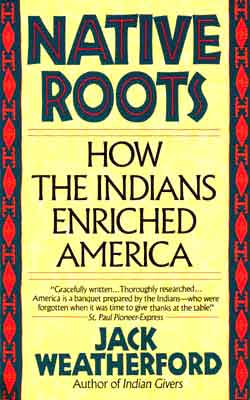
(Cover image is from the softcover edition.)
(From the back cover of the paperback edition)"In Indian Givers, anthropologist Jack Weatherford revealed how the cultural social, and political practices of the American Indians transformed the world. Now in Native Roots, Weatherford focuses on the vital role that Indian civilizations have played in the making of the United States.
"Conventional American history holds that the white
settlers of the New World re-created the societies they had known in England,
France and Spain. But, as Weatherford so brilliantly shows, Europeans in fact
grafted their civilization onto the deep and nourishing roots of Native American
customs and beliefs. Beneath the glass-and-steel skyscrapers of contemporary
Manhattan lies an Indian fur-trading post. Behind the tactics of modern
guerrilla warfare are the lightning-fast maneuvers of the Plains Indians. Our
place names, our farming and hunting techniques, our crafts, the very blood that
flows in our veins--all derive from American Indians in ways that we
consistently fail to see. In Weatherford's words, "Without understanding
Native Americans, we will never know who we are today in America."
The hardcover edition of Native Roots is presently out-of-print. The paperback edition is available for $12.95 US, plus shipping and handling.
![]() (We
are currently refurbishing and expanding these shelves and changing over to a
completely integrated payment system for our customers, but we will be happy to
honor orders received by e-mail during this interim. Click
button to send us your orders or comments.)
(We
are currently refurbishing and expanding these shelves and changing over to a
completely integrated payment system for our customers, but we will be happy to
honor orders received by e-mail during this interim. Click
button to send us your orders or comments.)
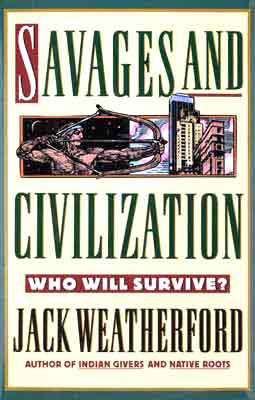 Savages and Civilization : Who Will Survive?
Savages and Civilization : Who Will Survive?
by Jack Weatherford
(Cover image is from the hardcover first edition- January 1994)
In one sense, Savages and Civilization is the third book in a trilogy begun with Indian Givers and Native Roots. In another, it stands very well on its own as a blisteringly fast and comprehensive anthropological tour of human history, from our beginnings as foragers to the effects of our urban-based "civilization."
As the third volume in a trilogy, Jack Weatherford is clearly picking up from the mention of Ab-ar-Rahman Ibn Khaldun's 14th Century identification of "the relationship between tribal and urban people as the key to understanding world history and human civilization," which he introduced in the first pages of Native Roots. In many ways, this volume can be seen as a marvelously effective, nearly 300-page exploration of this thesis. But Savages and Civilization is much more.
As a separate work, in its own right, it begins in a field of human bones high in Tibet and the questions that Weatherford was forced to confront, beginning in that place. Once again, he has favored us with a richly informed dialogue, framed around the questions, "How did human groups become so different from one another? Why is there still such tremendous variety in the world, and why does it persist? [and] Are the cultural differences among humans around the world increasing or decreasing?"
If you don't think these questions have any relevance to your daily doings, watch the local and national news tonight. Ask yourself how it came to this, and how long "it" has been going on. Then read this book.
Again and again, the author uses modern examples of ancient patterns as a backdrop for discussions of mankind's history as foragers, hunters, toolmakers, villagers, nomads, city builders and traders. Woven into this richly emerging fabric are treatments of the aboriginal "dreamtime," the ancient story of Gilgamesh and Enkidu, the current role of Alexander's legacy as it emerged from the coincidence of technology, language and alphabet, and countless other insights and examples. The reach of his reasoning and analysis, however, lies well beyond anthropology.
Many of us have had micro-experiences in dynamic systems that have gradually fallen into sameness, entropy and the stifling (if not suppression) of innovation, whether they be in business, governmental or cultural settings. Many of us have also ridden through the bottom of such cycles and experienced the revitalization of these same systems. Often, we have not paid close attention to the things that sparked upswing and re-energization. If we look honestly at the entire process we experienced, and move it into the larger settings that are of concern here, the author's argument that the collision between tribal ("savage") and urban ("civilized") cultures (and points of view) has "ignited cultural genius and innovation" rings true. So does his assertion that "The contact between cultures has been a driving force in world history."
For those readers who have not had such personal experiences consider, instead, Benjamin Franklin as the focus of contact between the Hellenic and Western European experience, and that of the Iroquois; or Benny Goodman as a pivot point between European music, Jewish sense and experience, and the stream of African-American musical traditions that had already blended with the music of other cultures and become jazz. Or just read this book—the examples are better, bigger, and more relevant.
As he has done so often, Jack Weatherford helps us to expand our sensing of the situation in which we find ourselves as individuals and groups by serving up rich helpings of little known or neglected information, and a fresh viewpoint that shares the internal processes that have informed his personal reasoning and growth. This is not just reading. This is enrichment.
It is so unbelievable that this book should already be out of print, that we have done something about it, as best we can.
(From the dustcover notes to the hardbound edition)
"In Indian Givers and Native Roots, renowned anthropologist Jack Weatherford wrote with insight about the epic clash between Native American and European cultures. Now, In Savages and Civilization, Weatherford widens his scope to illuminate a similar struggle that is intensifying today, but this time on a global scale of ethnic strife. From sub-Saharan Africa to the Arctic, from the rain forests that straddle the equator to the high plateau of Tibet, indigenous peoples are facing the loss of their cultural identities, but at the same time are demonstrating a growing resistance to the global civilization that threatens to engulf them."
"Just at the point where civilization seems to have overwhelmed other "tribal" and "uncivilized" societies, war, disease, famine, environmental degradation, and ethnic chaos place civilization on the brink of becoming a victim of its own success--and excess."
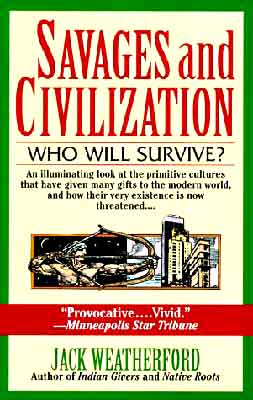
"Should civilization falter, Weatherford argues, those tribal peoples whom civilization once attempted to envelop may be the only ones capable of salvaging it. If we continue to destroy their culture, we may lose the knowledge that helped us survive the millions of years before agriculture and cities, before civilization. Those connections to the past must be preserved--and this may be the last chance to do so. As a result, Savages and Civilization will not only change how history and society are viewed, it will be sure to alter your own self-perception as well."
(This cover image is from the paperback edition.)
![]() (We
are currently refurbishing and expanding these shelves and changing over to a
completely integrated payment system for our customers, but we will be happy to
honor orders received by e-mail during this interim. Click
button to send us your orders or comments.)
(We
are currently refurbishing and expanding these shelves and changing over to a
completely integrated payment system for our customers, but we will be happy to
honor orders received by e-mail during this interim. Click
button to send us your orders or comments.)
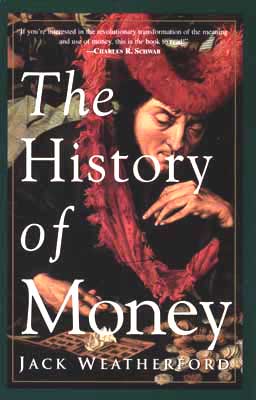 The History of
Money : From Sandstone to Cyberspace
The History of
Money : From Sandstone to Cyberspace
by Jack Weatherford
(Cover Image is from the paperback edition.)
OK, we'll admit it. This one sounded like it was going to be pretty dry. We really should have known better. It's fascinating.
There are large stretches of this book that read like, and pull the reader forward like, a good novel. Over and over, you find yourself asking, "Why didn't this stuff get a better treatment in the history classes I took and the news sources I read now?"
Looking back, we can see that there have been many times that it felt like there was a missing piece or two, whether the area of study was the Greek and Roman periods of Western Civilization, the Crusades and the "Dark Ages," the rise of manufacturing and the industrial revolution, or the events of the last half of the Twentieth Century. At the time, there was always a test to prepare for, a deadline to meet, a kid to take to gymnastics, a part time job to tide us over ... life got in the way of inquiry.
Here are a lot of those missing pieces, with contextual details so rich that you will have to find a way to recommend it to friends without waxing so prolix that they run away. Because, if our experience is any guide, you will find yourself recommending it.
What small European village gave birth to both the dollar and the atom bomb? What's been going on with checks, and ATM's, and credit cards, and social and economic stratification, and why should anybody care? What was The Wizard of Oz really about? Just how many layers are there to the old joke about being "worth your weight in plastic?" Why did everybody go off the gold standard? What is "virtual money" and why is it important to us regular folks? Why does University Avenue in Saint Paul pop up again? And what was the deal with Jacque de Molay, anyway?
Trust us on this one. You have nothing to lose but your credit cards.
(From the jacket of the paperback edition)
"In his most widely appealing book yet, cultural anthropologist Jack Weatherford traces our relationship with money. From primitive man's cowrie shells to the electronic cash card, from the markets of Timbuktu to the New York Stock Exchange, The History of Money explores how money and the myriad forms of exchange have affected humanity, and how they will continue to shape all aspects of our lives--economic, political, and personal."
Reviews
"A fascinating book about the force that makes the world go round--the dollars, pounds, francs, marks, bahts, ringits, kwansas, levs, biplwelles, yuans, quetazles, pf'angas, ngultrums, ouguiyas, and other 200-odd brand names that collectively make up the mysterious thing we call money." (Los Angeles Times)
"The History of Money stockpiles fascinating anecdotes and shining insights into humanity's long obsession with its most coveted possession." (Seattle Times)
From Booklist:
"Existing only by government fiat or popular consensus, money has been changed into many forms over thousands of years. Yet it has always had what Weatherford calls a "cultural configuration," meaning money exerts a social force beyond its abstract value. As an example of the big picture, Weatherford discusses the displacement of feudalism by commerce over the course of the Renaissance and illustrates this discussion with arresting anecdotes, for instance, the immolation of
Knights Templars, whose banking assets were coveted by France's king. Weatherford, building his reputation for skilled
storytelling, which extends back to such popular books as Indian Givers (1988), surveys offbeat tales of money's impact in such disparate episodes in economic history as hyperinflation in Weimar Germany, the etymology of the word dollar, and the dominance and demise of the gold standard. Weatherford concludes his history of Mammon on an interesting note: cash will increasingly be used by the poor for daily transactions while wealthier classes will rely on electronic forms of money,
such as "smart" cards and Internet exchanges. Could garner wide interest."
Gilbert Taylor
From Kirkus Reviews:
"An engagingly digressive audit of the mediums of exchange humankind has used and abused down through the years, from anthropologist Weatherford
(Savages and Civilization, 1994, etc.). Drawing on a wealth of sources, the author divides the history of money into three distinct stages. The first dates back nearly three millennia to the creation of coins in ancient Lydia (modern Turkey), whose best-known ruler, Croesus, has become a byword for affluence. The monetary market system spawned by the invention of coins, which eliminated the need to weigh gold for every transaction, eventually spread around the world, in the process destroying great empires and fostering development of a democratic and prosperous ancient Greek civilization. The Renaissance proved another turning point, bringing with it banks, paper money, and allied innovations that put paid to feudalism, opened the way for industrial capitalism, and financed the art and scholarship of the era. On the eve of the 21st century, according to Weatherford, the Global Village is about to enter an era of electronic money, which promises to produce socioeconomic, political, and cultural changes every bit as convulsive as those that racked earlier epochs. Which is not to say that the author deals in either doom or gloom. He simply offers a guided tour of the past and provides plausible scenarios for the future. Weatherford also studs his accessible text with scholarly delights that afford welcome respites from straightforward accounts of ATMs, currency speculation, the gold standard, hyperinflation, near money (food stamps, for example), and rates of exchange. Cases in point range from an appreciation of Edward Bellamy's prediction of credit cards in his utopian novel
Looking Backward (1888) through a discussion of the ways in which L. Frank Baum's
The Wonderful Wizard of Oz (1900) made an allegorical case for bimetallism. An entertaining, on-the-money introduction to precisely what makes the world go 'round."
— Copyright ©1996, Kirkus Associates, LP. All rights reserved.
The hardcover edition of The History of Money is presently out-of-print. The paperback edition is available for $12.95.
![]() (We
are currently refurbishing and expanding these shelves and changing over to a
completely integrated payment system for our customers, but we will be happy to
honor orders received by e-mail during this interim. Click
button to send us your orders or comments.)
(We
are currently refurbishing and expanding these shelves and changing over to a
completely integrated payment system for our customers, but we will be happy to
honor orders received by e-mail during this interim. Click
button to send us your orders or comments.)